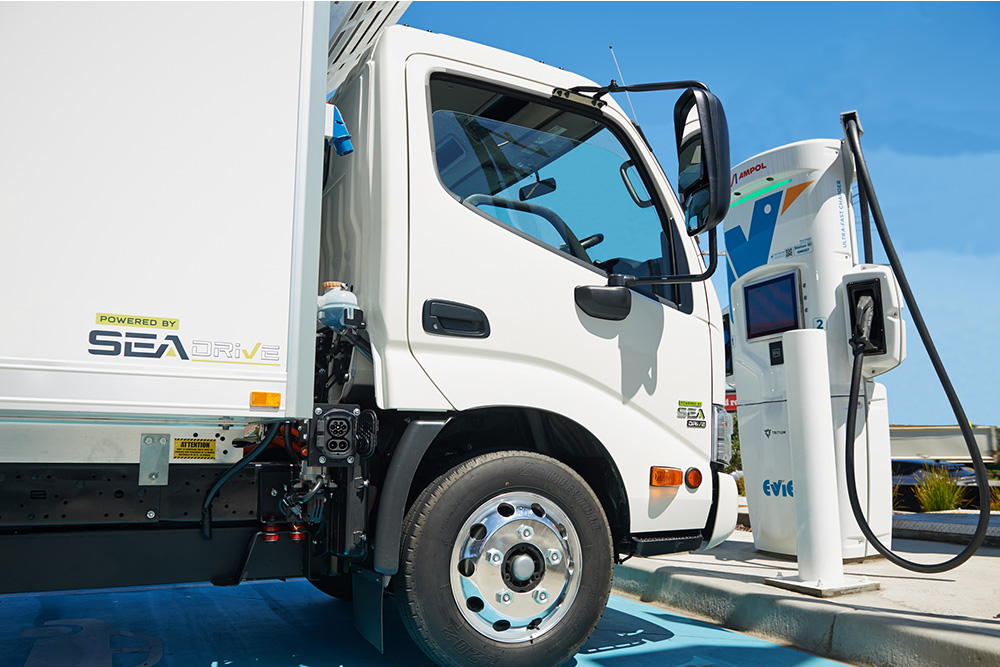Electric trucks will require reforms
Peak EV and trucking organisations say urgent reforms are needed to deliver a new era of electric trucks in Australia.

SEA Electric President, Asia Pacific Region, Bill Gillespie said that SEA Electric has been working closely with the Electric Vehicle Council and the ATA to develop the key pathways for zero-emission transport in Australia.
“We commend the work of the Electric Vehicle Council and the Australian Trucking Association in promoting the move to electric trucks and drafting these policies,” said Mr Gillespie.
“Australian industry will need encouragement and leadership to create a viable pathway towards zero-emission truck acquisition, with further work required by all levels of government in showing leadership.
“Given that the road freight sector accounts for 38 per cent of the country’s total transport emissions, it is SEA Electric’s view is that if Australia is planning to meet its 2050 net carbon emissions targets, then more broad-ranging government support will be required to ensure that companies can scale accordingly in an affordable manner.”
The comments come in the wake of the Electric Vehicle Council (EVC) and the Australian Trucking Association (ATA) releasing a statement calling for urgent policy reforms to deliver new era of electric trucks in Australia.
In what is claimed as an Australian first, the EVC and ATA collaborated to develop policies they believe necessary to drive the electrification of trucks in Australia.
In a joint statement the organisations said electrification would assist trucking businesses and supply chains by ending volatile diesel costs, reducing maintenance costs, improving urban efficiency, and delivering better conditions for truck drivers.
The statement said Australia currently lags most of the world in the electrification of trucks making the need for reform urgent. Of the 58 electric truck models available in North America, Europe, and China only 14 are available to the Australian market.

Among the key recommendations put forward by the EVC/ATA are proposals to exempt electric trucks from urban curfews, change Australian weight and width limits to accommodate batteries, and exempting electric trucks form stamp duty.
"Every government in Australia has committed to net-zero, but this can't be achieved without decarbonising the transport sector,” said EVC CEO Behyad Jafari.
"Curfew-free operations are a huge opportunity, creating benefits for operators optimising fleet operations and to the community through reducing peak hour traffic and congestion.”
Mr Jafari called on the federal government to swiftly implement the recommendations, saying doing so would provide massive benefits to Australian trucking, the economy, and environment.
"The AdBlue shortage crisis was a potent warning about our extreme fuel insecurity. Why should Australia be dependent on China and the Middle East to keep itself moving when we could be using homegrown power? Being able to power our supply chains with local electricity is a surely a national sovereignty imperative," Mr Jafari said.
Australian Trucking Association Chair, David Smith said electric power will be a game changer for the industry.
“It costs about $117 to fuel a diesel truck for 300km, but just $18 for an electric truck,” Mr Smith said.
“If Australia gets left behind on the transition to electric and zero emission trucks, we risk our supply chains and exporters getting stuck with high, globally uncompetitive per km freight costs.”
“Trucking operators face a number of barriers to buy and use an electric truck and these must be addressed to lower freight costs, improve fuel security and reduce emissions.”
Key recommendations from the new EVC/ATA policy agreement include:
- Truck width should be increased to align with standards used by major supplier economies (current width standards preclude many electric truck models from being used in Australia)
- One tonne concession for electric and zero emission trucks (Australia’s steer axle mass limit, currently 6.5 tonnes, is holding back the deployment of larger electric truck models due to the weight of batteries)
- Electric trucks to be exempt from urban curfews (electric trucks are much quieter and therefore do not require curfews)
Mandate Euro VI emissions standards for new heavy vehicle models from 2024 (this would bring standards into force 3.5 years earlier than proposed in the government’s draft Regulation Impact Statement) - Incentive payment to reduce the cost of installing charging infrastructure at depots
- Investment in public charging infrastructure to support on route electric truck charging
- Incentive payment to reduce the upfront purchase price difference between electric/zero emission trucks and internal combustion engine trucks (In California and Germany incentives are provided to reduce or eliminate the price difference for battery, fuel cell and trolley hybrid drive systems. The upfront purchase price of an electric truck can be double its diesel equivalent)
- Exempt electric and zero emission trucks from stamp duty
- Set sales target for zero-emission trucks of 30 per cent by 2030 and 100 per cent by 2040 (this goal is to drive ambition and measure the success or failure of existing incentives)
Related topics
Things to note
The information in this article has been prepared for general information purposes only and is not intended as legal advice or specific advice to any particular person. Any advice contained in the document is general advice, not intended as legal advice or professional advice and does not take into account any person’s particular circumstances. Before acting on anything based on this advice you should consider its appropriateness to you, having regard to your objectives and needs.
Insurance Products (excluding Travel Insurance) are issued by RACQ Insurance Limited ABN 50 009 704 152 (RACQI) and arranged by its agent, RACQ Distribution Services Pty Ltd (RDS) ABN 35 116 361 650, AFSL 567130 and RDS' authorised representatives (including RACQ Operations Pty Ltd ABN 80 009 663 414, AR No. 234978 (RACQO). Conditions, limits and exclusions apply. RDS and RACQO are in the RACQ group of companies. One of the companies in the RACQ group of companies has a minority shareholding in RACQI.
RDS and RACQO have not taken your personal objectives, circumstances or needs into account when preparing advice regarding insurance products and you will need to consider whether the advice is appropriate for you. Read the Product Disclosure Statement (PDS) and any applicable Supplementary PDS before making a purchase decision on this product. You can also access our Target Market Determinations on this website. RDS receives a commission from RACQI for the policies it arranges. RACQO receives fees paid for services it provides to RDS. Further details about remuneration are available on request prior to purchasing.
Banking and loan products issued by Members Banking Group Limited ABN 83 087 651 054 AFSL/Australian credit licence 241195 trading as RACQ Bank. Terms, conditions, fees, charges and lending policies apply. This is general advice only and may not be right for you. This information does not take your personal objectives, circumstances or needs into account. Read the disclosure documents for your selected product or service, including the Financial Services Guide and the Terms and Conditions, and consider if appropriate for you before deciding.
Except for RACQ Bank, any RACQ entity referred to on this page is not an authorised deposit-taking institution for the purposes of the Banking Act 1959 (Cth). That entity’s obligations do not represent deposits or other liabilities of RACQ Bank. RACQ Bank does not guarantee or otherwise provide assurance in respect of the obligations of that entity, unless noted otherwise.
RACQ Bank subscribes to the Customer Owned Banking Code of Practice which establishes higher standards than the law requires. The Code reflects modern consumer expectations and developments in approaches to issues such as consumer vulnerability, guarantors, and supporting customers through financial hardship. Please read our Customer Owned Banking Code of Practice page for more information.
RACQ Operations Pty Ltd (ABN 80 009 663 414 AR 000234978) and Members Travel Group Pty Ltd (ABN 45 144 538 803 AR 000432492) are acting as an Authorised Representative of the issuer of the insurance, Tokio Marine & Nichido Fire Insurance Co., Ltd. (ABN 80 000 438 291 AFSL 246 548). Any advice set out above is general in nature only, and does not take into account your objectives, financial situation or needs. Before purchasing any travel products, please consider the RACQ Travel Insurance Product Disclosure Statement (PDS) and the Target Market Determinations (TMDs) that apply to these products. Whilst the PDS outlines the Terms and Conditions of these products, the TMDs outline the intended class of customers that comprise the target market for these travel products. This will allow you to consider which products best suit your objectives, financial situation and needs and consider the products appropriateness to your personal circumstances. TMDs also outline matters involving the distribution and the review of these products. The PDS, Supplementary PDS and TMDs for each travel product can be found here.

